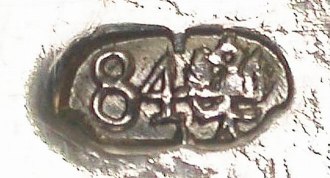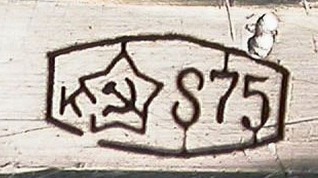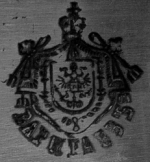by Willand
Ringborg
|
click on images to enlarge
RUSSIAN FAKES
At first sight, the calling card case
illustrated in
January Members' Window is
stamped correctly according to Russian hallmarking and assaying
regulations, it is nothing curious with the later Soviet time
stamp, it is fairly common as it was sometimes necessary to
re-stamp before resale or to present to a pawn-shop.
Annoying, and which is arising some doubts, the motive does not
seem to be of Russian style or tradition, rather, as mentioned,
China and Far East.
..
..But, the hallmark by the assayer shown in the photo, the
double-headed eagle was used in assaying as coat-of arms for St
Petersburg up to 1751 and then replaced by the well-known
crossed anchors and scepter
....and the oval assay stamp shown in the photo was introduced
1882 and used to 1889, so maybe we here we have an anomaly?
..
.
...but, is it a double-headed eagle? It seems as it has only
one head and that is the coat-of-arms of Poland and Warsaw! And
Warsaw was under the imperial Russian assaying regime from
1860s to the 90s, consistent to the
assay mark regime from 1882 and stamped fineness 84?.....
....but, is it not something wrong with the eagle, it looks
more like a butterfly or a dragon, and it seems to have one and
a half head? Where have we seen such an eagle?
This is an eagle zoomed up from a much lesser stamp, namely
the additional stamp of a supplier to the Russian imperial
court. These stamps contain the Romanoff family coat-of-arms, -
the double eagle - they are small, vary from supplier to
supplier, they are less distinctive and precise, and sometimes
look as butterflies.
A forger has been in action. How can we be sure of that? By the
4 in the fineness stamp 84 on the left half of the stamp. The
assaying double stamp from 1882 was distinctly divided in two
halves and each sign in each half fully included in that part.
In this stamp parts of the digit 4 violate this and are
exceeding the center line. The stamp is a forgery.
°°°°°°°°°°°°°°
.But, maybe the silver of fineness 84 zolotniki exactly
corresponds to the fineness of 875/000 in the later stamp?
If so, this is maybe an antique Russian object? The Soviet sharp
stamp of a star with hammer and sickle is there, the letter K
for Kiev and 875 for fineness in an oval, double cut, this is
exactly what should be there according to the assay rules after
1958. Yes,
..
.but, isnt it something wrong with the 8? It looks like a S.
.and, why is 875 not in line, why is 7 a little higher up?.....
and why are all the digits hooked to the frame by a minor
connecting strip?.... and why is the letter K connected to the
star? The letter should be hanging free.
.and why is the star
connected to the oval frame?... and why is the star open in the
direction south-west?... and why is the outer frame open in the
same direction? These observations are not in line with how it
should look like.
The forger has probably used a sheet of iron, used fine scissors
as when cutting a piece of paper as when doing a silhouette and
finally made the cut of the outer frame of the double cut oval,
welded the pattern to a stronger piece of iron, and,
.stamped.
The reconstruction of this kind of craftsmanship is of course
speculative, but nevertheless, this stamp, on the same calling
card case, is also a forgery.
The crook that made the stamps has made a common mistake; he was
misreading Russian assay regulations and did put too much effort
in producing these stamps compared to the effort to decode the
falsification.
°°°°°°°°°°°°°°
In the same Members' Window Giorgio
Busetto shows a different
fake on another piece, where the forger, unfamiliar with the
Cyrillic alphabet, turn it in front and behind. The stamp from a
court supplier he was intending to copy was probably not
Kurliokov, but Chlebnikov, but mixing it all up. Nevertheless
the cross over the girl with the kokoshnik, the identity mark,
is a sign of that the piece was to be taken abroad and then, to
be re-stamped, if brought back to Russia. This stamp is
extremely seldom seen, why pay a stamp fee if you are moving
abroad or selling something to a foreigner? The photo does not
allow a thorough examination of the stamp, but in the context,
the authenticity of the hallmarking is to be doubted.
(In the mark above the Cyrillic characters are wrong.
They look right in the mirrored image below )
The calling card case first shown,
regardless of silver content, is extremely valuable as an
example of faked stamps and how they are used in combination to
offer a story that the evidence for proof is present. Flea
markets do not often represent the best expertise in Russian
hallmarking, and if this piece was offered as authentic by a
professional antique dealer, then there are reasons to mistrust
that profession, and maybe also experts from museums
..
..but, there is always access to some additional expertise
available, - the ASCAS family.
Willand Ringborg
- 2008 -
|
|
 ASSOCIATION OF SMALL COLLECTORS OF ANTIQUE SILVER
ASSOCIATION OF SMALL COLLECTORS OF ANTIQUE SILVER



